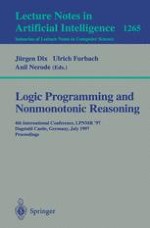1997 | Buch
Logic Programming And Nonmonotonic Reasoning
4th International Conference, LPNMR '97 Dagstuhl Castle, Germany, July 28–31, 1997 Proceedings
herausgegeben von: Jürgen Dix, Ulrich Furbach, Anil Nerode
Verlag: Springer Berlin Heidelberg
Buchreihe : Lecture Notes in Computer Science
Enthalten in: Professional Book Archive
